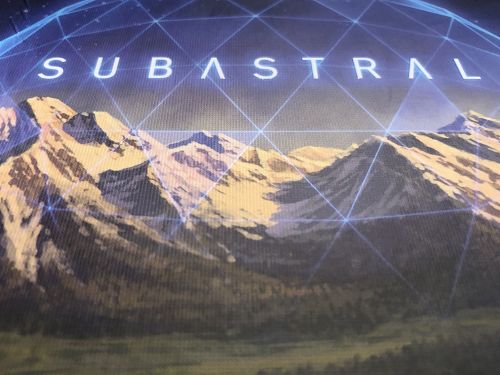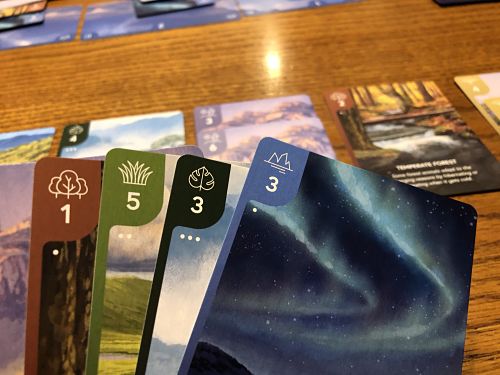Subastral Review
Designer: Ben Pinchback, Matt Riddle
Artist: Beth Sobel
Publisher: Renegade Game Studios
Year Published: 2021
No. of Players: 2-5
Ages: 10+
Playing Time: 15-30 minutes
Main mechanic / Theme: Card Drafting & Set Collection; Environmental
An elegant game of drafting and set collection, all wrapped up in gorgeous art.
Find more info on BoardGameGeek.com
Overview:
Play and draft cards in order to fill in your biome journal with both matching and mixed sets. What you play on the cloud cards can be collected by other players, so work on maximizing your benefits while minimizing theirs.

Gameplay and Mechanisms:

The game starts with six Cloud cards set up in a row, numbered 1-6, with the Biome deck at the far left and the Sun card at the far right. Each Cloud has at least one Biome card at it, with two Cloud cards having two Biome cards. Players also start with a hand of three Biome cards. From here, the first player starts the game off by deciding to play one of their Biome cards on a cloud.
But wait! Didn’t you say you’re trying to complete your journal? Why, yes I did! But you cannot play cards from your hand directly to your journal. Rather, you have to collect cards from the clouds to place in your journal. So, the cloud you place your card at will determine what you can do.
When playing a Biome card to a cloud, its number must match that of the cloud it’s played on. If you choose to take cards from a cloud toward the Biome deck, those cards go straight into your hand. If you take the cards from a cloud toward the Sun card, those cards are placed in your journal.
And that’s the game. More or less. Obviously, there is more to it than that, but playing the game itself is super simple. The trick comes in when and from where you collect cards for your journal. Whenever you collect cards for your journal, cards of the same biome are placed in a column (to show how many of that type of card you have). Different Biome cards are arranged to the right of the first Biome card you played in your journal, with any others of its kind being played below it. So, you’re going to have a long line of different biomes, and some columns with multiples of the same biome. This will affect scoring.
At the end of the game, you get points for the length of each row of mixed Biome cards, from left to right, until there is a break in the row (i.e. due to one column not having as many cards in it as those before it). You also score points for the two biome columns with the most cards in it. Ties are broken by starting from the left-most pile and moving to the right. When scoring in this manner, you count the number of biomes in that column and multiply that by the column number. So, if I had 4 of a certain biome in the first column I would get 4 points (4 x 1 = 4). However, if I have 3 of the same biome in column 6, I would get 18 points (3 x 6 = 18). So you can see how important it is to go for cards that appear at the end of your first row in order to maximize your points.

The card drafting and planning ahead for end-game scoring is a thinky mixture, one that has a lot more depth than may appear at first glance. I’ve played it at many player counts, and they all play well.
I really love how the early game makes you think about which biomes you want in which column, and then throughout the game, you’re trying to capitalize on how you laid out your first row. However, if you only focus on the right-most cards of your journal, you’ll miss out on points for your mixed rows. So there’s a lot to think about, and a lot to plan for.
Theme, Artwork, etc.
The art is gorgeous! And that’s to be expected since the illustrious Beth Sobel did the art. And the Biome cards have neat facts about each biome as well, which is fun and educational and really adds to the theme. I love the looks of the cards; they really do make this game shine. The rules are easy to follow, and there’s really so much to love about how everything is all put together.

What Worked:
I love how you must play cards down in order to get more cards, but the cards you play will likely help someone. This aspect of drafting really gives the game some good depth.

Final Thoughts:
This game is all about set collection, so if you like that mechanism, there’s a lot to love here. The educational snippets are great and the small size of the box makes it a great game to take pretty much anywhere. It’s quick, too, so you can get in multiple games back to back (to back). Renegade Game Studios always impresses me with the quality of their smaller games, and Subastral is no exception. I really enjoy playing it, and it’s great for a quick family game or for a few plays at game night.
Subastral is a solid, solid game. I’d even go so far as to call it “elegant.” If you like set-collection, card drafting, or just amazing art, you may need to check out Subastral.

Benjamin Kocher

Benjamin hails from Canada but now lives in Kentucky with his wife and kids. He’s a certified copyeditor and a freelance writer and editor, covering everything from board game rule books to novels. An avid writer of science fiction and fantasy, it comes as no surprise that his favorite board games are those with rich, engaging themes. He is a reviewer for Board Game Atlas and runs his own site, Board Game Immersion, where he focuses on storytelling within games. When he’s not writing or playing games, Benjamin loves to play ultimate Frisbee, watch and play rugby, and read the most epic fantasy books available. Follow him on Twitter @benjaminkocher and Instagram @benjamin_kocher. You can also read his board game inspired fiction at Board Game Immersion.


